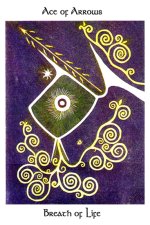Mi-Shell
From Chesca's notes:
The Aces: major arcana: Ancestor Position on wheel: Imbolc. Chakra: crown.
Ace of Arrows: Breath of Life
This image shows the head of the chalk hill figure cut in turf at Uffington, S.England. (See also The Sun and The Horse). There was once a long barrow for burials built within her mouth so that symbolically she gives the breath of life to the dead. Her eye is open and radiant, as new life is envisioned.
The morning star illuminates the night sky, and the mare breathes light into the frosty February air. Tender and gentle love that revives one with the ‘kiss’ of life. Renewal of inspiration, a reconnection to life, truth and wisdom, spoken from the horses mouth.
The Aces: major arcana: Ancestor Position on wheel: Imbolc. Chakra: crown.
Ace of Arrows: Breath of Life
This image shows the head of the chalk hill figure cut in turf at Uffington, S.England. (See also The Sun and The Horse). There was once a long barrow for burials built within her mouth so that symbolically she gives the breath of life to the dead. Her eye is open and radiant, as new life is envisioned.
The morning star illuminates the night sky, and the mare breathes light into the frosty February air. Tender and gentle love that revives one with the ‘kiss’ of life. Renewal of inspiration, a reconnection to life, truth and wisdom, spoken from the horses mouth.





